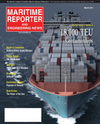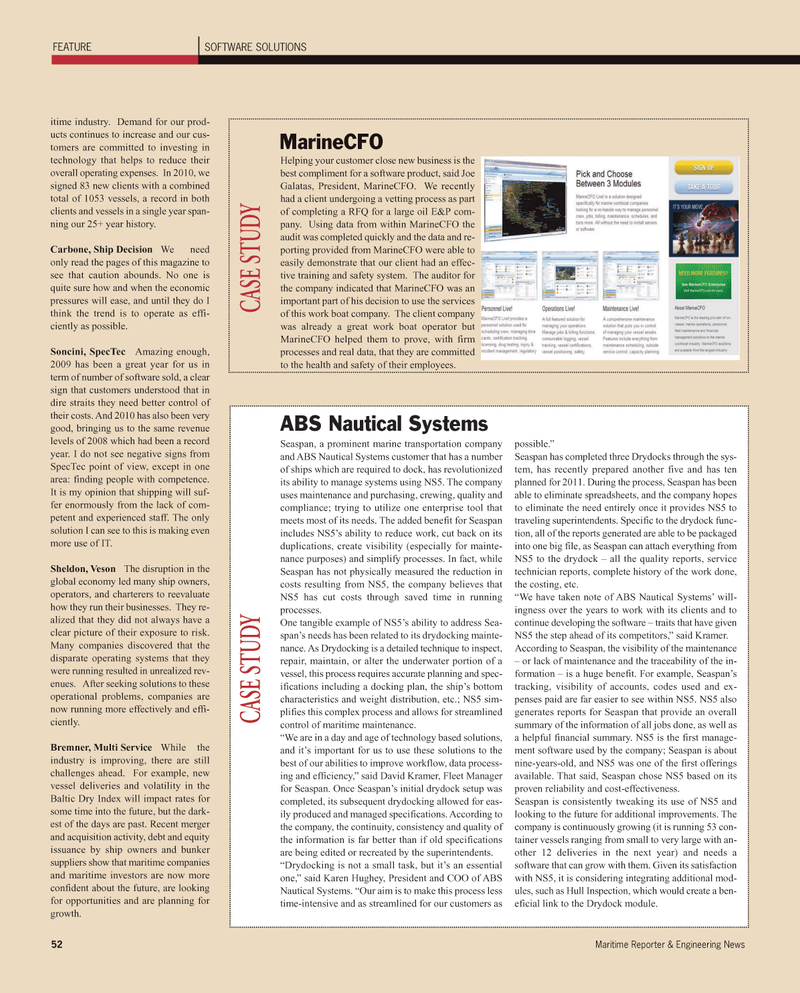
Page 52: of Maritime Reporter Magazine (March 2011)
Ship Repair & Conversion
Read this page in Pdf, Flash or Html5 edition of March 2011 Maritime Reporter Magazine
52 Maritime Reporter & Engineering News
FEATURE SOFTWARE SOLUTIONS itime industry. Demand for our prod- ucts continues to increase and our cus- tomers are committed to investing in technology that helps to reduce their overall operating expenses. In 2010, we signed 83 new clients with a combined total of 1053 vessels, a record in both clients and vessels in a single year span- ning our 25+ year history.
Carbone, Ship Decision We need only read the pages of this magazine to see that caution abounds. No one is quite sure how and when the economic pressures will ease, and until they do I think the trend is to operate as effi- ciently as possible.
Soncini, SpecTec Amazing enough, 2009 has been a great year for us in term of number of software sold, a clear sign that customers understood that in dire straits they need better control of their costs. And 2010 has also been very good, bringing us to the same revenue levels of 2008 which had been a record year. I do not see negative signs from
SpecTec point of view, except in one area: finding people with competence.
It is my opinion that shipping will suf- fer enormously from the lack of com- petent and experienced staff. The only solution I can see to this is making even more use of IT.
Sheldon, Veson The disruption in the global economy led many ship owners, operators, and charterers to reevaluate how they run their businesses. They re- alized that they did not always have a clear picture of their exposure to risk.
Many companies discovered that the disparate operating systems that they were running resulted in unrealized rev- enues. After seeking solutions to these operational problems, companies are now running more effectively and effi- ciently.
Bremner, Multi Service While the industry is improving, there are still challenges ahead. For example, new vessel deliveries and volatility in the
Baltic Dry Index will impact rates for some time into the future, but the dark- est of the days are past. Recent merger and acquisition activity, debt and equity issuance by ship owners and bunker suppliers show that maritime companies and maritime investors are now more confident about the future, are looking for opportunities and are planning for growth.
Helping your customer close new business is the best compliment for a software product, said Joe
Galatas, President, MarineCFO. We recently had a client undergoing a vetting process as part of completing a RFQ for a large oil E&P com- pany. Using data from within MarineCFO the audit was completed quickly and the data and re- porting provided from MarineCFO were able to easily demonstrate that our client had an effec- tive training and safety system. The auditor for the company indicated that MarineCFO was an important part of his decision to use the services of this work boat company. The client company was already a great work boat operator but
MarineCFO helped them to prove, with firm processes and real data, that they are committed to the health and safety of their employees.
CASE STUD
Y
MarineCFO
Seaspan, a prominent marine transportation company and ABS Nautical Systems customer that has a number of ships which are required to dock, has revolutionized its ability to manage systems using NS5. The company uses maintenance and purchasing, crewing, quality and compliance; trying to utilize one enterprise tool that meets most of its needs. The added benefit for Seaspan includes NS5’s ability to reduce work, cut back on its duplications, create visibility (especially for mainte- nance purposes) and simplify processes. In fact, while
Seaspan has not physically measured the reduction in costs resulting from NS5, the company believes that
NS5 has cut costs through saved time in running processes.
One tangible example of NS5’s ability to address Sea- span’s needs has been related to its drydocking mainte- nance. As Drydocking is a detailed technique to inspect, repair, maintain, or alter the underwater portion of a vessel, this process requires accurate planning and spec- ifications including a docking plan, the ship’s bottom characteristics and weight distribution, etc.; NS5 sim- plifies this complex process and allows for streamlined control of maritime maintenance. “We are in a day and age of technology based solutions, and it’s important for us to use these solutions to the best of our abilities to improve workflow, data process- ing and efficiency,” said David Kramer, Fleet Manager for Seaspan. Once Seaspan’s initial drydock setup was completed, its subsequent drydocking allowed for eas- ily produced and managed specifications. According to the company, the continuity, consistency and quality of the information is far better than if old specifications are being edited or recreated by the superintendents. “Drydocking is not a small task, but it’s an essential one,” said Karen Hughey, President and COO of ABS
Nautical Systems. “Our aim is to make this process less time-intensive and as streamlined for our customers as possible.”
Seaspan has completed three Drydocks through the sys- tem, has recently prepared another five and has ten planned for 2011. During the process, Seaspan has been able to eliminate spreadsheets, and the company hopes to eliminate the need entirely once it provides NS5 to traveling superintendents. Specific to the drydock func- tion, all of the reports generated are able to be packaged into one big file, as Seaspan can attach everything from
NS5 to the drydock – all the quality reports, service technician reports, complete history of the work done, the costing, etc. “We have taken note of ABS Nautical Systems’ will- ingness over the years to work with its clients and to continue developing the software – traits that have given
NS5 the step ahead of its competitors,” said Kramer.
According to Seaspan, the visibility of the maintenance – or lack of maintenance and the traceability of the in- formation – is a huge benefit. For example, Seaspan’s tracking, visibility of accounts, codes used and ex- penses paid are far easier to see within NS5. NS5 also generates reports for Seaspan that provide an overall summary of the information of all jobs done, as well as a helpful financial summary. NS5 is the first manage- ment software used by the company; Seaspan is about nine-years-old, and NS5 was one of the first offerings available. That said, Seaspan chose NS5 based on its proven reliability and cost-effectiveness.
Seaspan is consistently tweaking its use of NS5 and looking to the future for additional improvements. The company is continuously growing (it is running 53 con- tainer vessels ranging from small to very large with an- other 12 deliveries in the next year) and needs a software that can grow with them. Given its satisfaction with NS5, it is considering integrating additional mod- ules, such as Hull Inspection, which would create a ben- eficial link to the Drydock module.
CASE STUD
Y
ABS Nautical Systems

 51
51

 53
53
